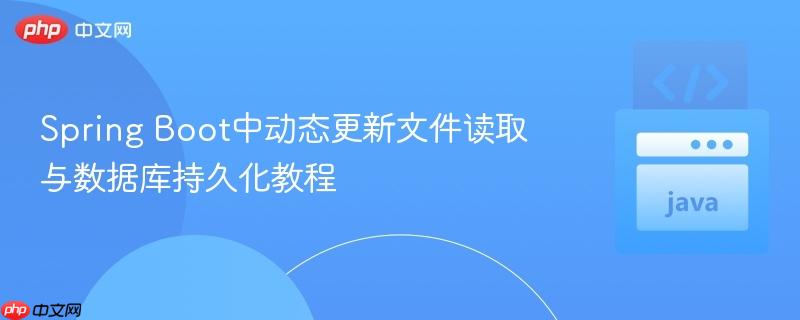
本教程详细介绍了在spring boot应用中如何正确读取不断更新的外部文件,并将其数据持久化到数据库。它解决了使用`getresourceasstream`无法获取动态文件更新的问题,通过直接文件系统访问、`@scheduled`任务调度和最佳实践(如构造器注入)来确保数据实时同步,从而实现高效可靠的数据处理流程。
在构建现代企业应用时,我们经常会遇到需要从外部文件读取数据并同步到数据库的场景。特别是当这些文件内容会持续更新时,如何确保Spring Boot应用能够实时捕获这些变化并进行处理,是一个常见的挑战。本文将深入探讨在Spring Boot中读取动态更新文件并将其持久化到数据库的最佳实践。
许多开发者在尝试读取文件时,会习惯性地使用Class.getResourceAsStream()方法,例如:
InputStream inputStream = MasterList.class.getResourceAsStream("/json/file.json");这种方法适用于读取打包在JAR/WAR文件内部的静态资源(位于src/main/resources目录下)。然而,它的核心局限在于:它读取的是应用程序启动时已打包好的资源副本。这意味着,如果src/main/resources/json/file.json文件在应用程序运行期间被外部进程或应用程序自身修改,getResourceAsStream()将无法获取到这些动态更新,它始终会返回打包时的旧内容。这正是导致数据无法实时更新到数据库的根本原因。
要读取一个在运行时会动态更新的文件,应用程序必须直接通过文件系统路径来访问它,而不是将其视为一个内部资源。这意味着该文件不应放置在src/main/resources目录下,而应该放在一个可配置的外部路径。
为了提高灵活性和可维护性,我们应该将外部文件的路径配置在application.properties或application.yml中。
application.properties示例:
app.data.json-file-path=/path/to/your/external/json/file.json # 或者使用相对路径,但需确保应用程序有权限访问 # app.data.json-file-path=./data/file.json
Spring Boot应用可以通过@Value注解注入配置的路径,然后使用java.nio.file.Files或java.io.BufferedReader等API来直接读取文件内容。
核心代码片段:
import java.nio.file.Files;
import java.nio.file.Paths;
import java.io.IOException;
import java.io.InputStream; // 仍然可以使用,但需要从Files.newInputStream获取
// ... 其他导入
@Value("${app.data.json-file-path}")
private String jsonFilePath;
public void readFileAndPersist() {
ObjectMapper mapper = new ObjectMapper();
TypeReference<List<Master>> typeReference = new TypeReference<List<Master>>(){};
try {
// 使用Files.newInputStream直接从文件系统读取
try (InputStream inputStream = Files.newInputStream(Paths.get(jsonFilePath))) {
List<Master> masters = mapper.readValue(inputStream, typeReference);
System.out.println("读取到数据: " + masters);
// 将数据保存到数据库
masterService.save(masters);
System.out.println("数据已保存到数据库。");
}
} catch (IOException e) {
System.err.println("无法读取或保存数据: " + e.getMessage());
// 实际应用中应记录更详细的日志
}
}Spring Boot提供了强大的@Scheduled注解,可以方便地实现定时任务。结合直接文件访问,我们可以周期性地读取更新的文件并同步数据。
在Spring Boot主应用类上添加@EnableScheduling注解以启用定时任务。
package com.example.demo;
import org.springframework.boot.SpringApplication;
import org.springframework.boot.autoconfigure.SpringBootApplication;
import org.springframework.scheduling.annotation.EnableScheduling;
import org.springframework.transaction.annotation.EnableTransactionManagement;
@SpringBootApplication
@EnableScheduling // 启用定时任务
@EnableTransactionManagement
public class ReadAndWriteJsonApplication {
public static void main(String[] args) {
SpringApplication.run(ReadAndWriteJsonApplication.class, args);
}
}在需要执行定时任务的组件中(例如,主应用类或一个专门的服务类),使用@Scheduled注解标记方法。
package com.example.demo;
import com.example.demo.Services.MasterService;
import com.example.demo.model.Master;
import com.fasterxml.jackson.core.type.TypeReference;
import com.fasterxml.jackson.databind.ObjectMapper;
import org.springframework.beans.factory.annotation.Autowired; // 暂时保留,但后续会优化为构造器注入
import org.springframework.beans.factory.annotation.Value;
import org.springframework.scheduling.annotation.Scheduled;
import org.springframework.stereotype.Component; // 可以将此逻辑放入一个组件类
import java.io.IOException;
import java.io.InputStream;
import java.nio.file.Files;
import java.nio.file.Paths;
import java.util.List;
@Component // 将此逻辑封装在一个Spring组件中
public class FileProcessorScheduler {
private final MasterService masterService;
@Value("${app.data.json-file-path}")
private String jsonFilePath;
// 推荐使用构造器注入
public FileProcessorScheduler(MasterService masterService) {
this.masterService = masterService;
}
@Scheduled(fixedRate = 90000) // 每90秒执行一次
public void readAndUpdateDatabase() {
System.out.println("定时任务启动:尝试读取文件并更新数据库...");
ObjectMapper mapper = new ObjectMapper();
TypeReference<List<Master>> typeReference = new TypeReference<List<Master>>(){};
try {
// 使用Files.newInputStream直接从文件系统读取
try (InputStream inputStream = Files.newInputStream(Paths.get(jsonFilePath))) {
List<Master> masters = mapper.readValue(inputStream, typeReference);
System.out.println("成功读取到 " + masters.size() + " 条数据。");
// 将数据保存到数据库
masterService.save(masters);
System.out.println("数据已成功保存/更新到数据库。");
}
} catch (IOException e) {
System.err.println("定时任务执行失败:无法读取或保存数据: " + e.getMessage());
// 生产环境中应使用日志框架记录异常
}
}
}在Spring框架中,推荐使用构造器注入(Constructor Injection)而不是字段注入(Field Injection,即直接在字段上使用@Autowired)。
优点:
修改MasterService以使用构造器注入:
package com.example.demo.Services;
import com.example.demo.Repository.MasterRepository;
import com.example.demo.model.Master;
import org.springframework.stereotype.Service;
import java.util.List;
@Service
public class MasterService {
private final MasterRepository masterRepository; // 使用final修饰
// 构造器注入
public MasterService(MasterRepository masterRepository) {
this.masterRepository = masterRepository;
}
public Iterable<Master> list() {
return masterRepository.findAll();
}
public Master save(Master master){
return masterRepository.save(master);
}
public Iterable<Master> save(List<Master> masters) {
return masterRepository.saveAll(masters);
}
}为了使教程更完整,我们提供Master实体类和MasterRepository的示例。
Master实体类 (com.example.demo.model.Master):
package com.example.demo.model;
import jakarta.persistence.Entity;
import jakarta.persistence.GeneratedValue;
import jakarta.persistence.GenerationType;
import jakarta.persistence.Id;
import lombok.Data;
@Entity
@Data // Lombok注解,自动生成getter/setter/equals/hashCode/toString
public class Master {
@Id
@GeneratedValue(strategy = GenerationType.IDENTITY)
private Long id;
private String name;
private int value;
// JPA需要无参构造函数
public Master() {}
public Master(String name, int value) {
this.name = name;
this.value = value;
}
}MasterRepository接口 (com.example.demo.Repository.MasterRepository):
package com.example.demo.Repository;
import com.example.demo.model.Master;
import org.springframework.data.repository.CrudRepository;
import org.springframework.stereotype.Repository;
@Repository
public interface MasterRepository extends CrudRepository<Master, Long> {
}application.properties 配置:
# 数据库配置 (示例,请根据实际情况修改) spring.datasource.url=jdbc:h2:mem:testdb spring.datasource.driverClassName=org.h2.Driver spring.datasource.username=sa spring.datasource.password=password spring.jpa.database-platform=org.hibernate.dialect.H2Dialect spring.h2.console.enabled=true spring.jpa.hibernate.ddl-auto=update # 生产环境请谨慎使用,建议为validate或none # 外部JSON文件路径 # 请确保此路径存在且Spring Boot应用有读写权限 # 例如,在项目根目录下创建一个 'data' 文件夹,并在其中放置 'file.json' app.data.json-file-path=./data/file.json
示例file.json内容 (放置在./data/file.json):
[
{
"name": "Item A",
"value": 100
},
{
"name": "Item B",
"value": 200
}
]当file.json被更新为:
[
{
"name": "Item C",
"value": 300
},
{
"name": "Item D",
"value": 400
}
]定时任务将读取到新数据并更新到数据库。
通过遵循上述指导原则,您的Spring Boot应用程序将能够有效地读取和处理动态更新的外部文件,确保数据库数据的实时性和准确性。
以上就是Spring Boot中动态更新文件读取与数据库持久化教程的详细内容,更多请关注php中文网其它相关文章!

每个人都需要一台速度更快、更稳定的 PC。随着时间的推移,垃圾文件、旧注册表数据和不必要的后台进程会占用资源并降低性能。幸运的是,许多工具可以让 Windows 保持平稳运行。

Copyright 2014-2025 https://www.php.cn/ All Rights Reserved | php.cn | 湘ICP备2023035733号